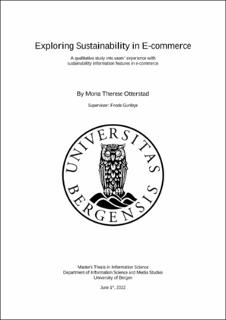| dc.description.abstract | The textile and clothing industry is one of the largest polluters of our time, being responsible for 10 % of all yearly emissions. During all stages of production, there is environmental impact, from the production of fibres, both plant-based and animalistic, to the spinning of the fibres into textiles to the sewing and construction of garments, in addition to chemical treatments. Online retailers offering textile products present information about their sustainability profile and the sustainability of their products, but how this is done differs from retailer to retailer. To investigate how sustainability information is presented and how it is perceived by consumers, an explorative examination of a selection of Norway’s most popular online retailers was performed, and a qualitative semistructured interview was constructed. The interview included the observational technique think-aloud to gain insight into how the sustainability information was experienced by participants. The gathered data was analysed using thematic analysis and results from the think-aloud session structured using the framework of the traditional consumer decision-making process. The results show that the sustainability information features offered today can be said to convey information either about the sustainability profile of a retailer, or to convey information about the sustainability of an offered product. Terminology for the different sustainability information features was also created from this. Sustainability information features were experienced by consumers as notions of it being positive features to have for those that were sustainably conscious emerged. A sustainability profile implemented throughout was seen as more trustworthy than those that were perceived to be placed as a second thought. Mistrust due to previous greenwashing was also discovered. Solutions to mitigate these were given to be concise language, use of third-party environmental labels and having sustainability information displayed openly and easily accessible. | |
